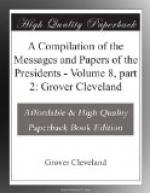The proposition of the President for the appointment of a joint commission, with an umpire, to decide upon all points on which the two Governments disagree was then presented. It was accompanied by a suggestion that the controversy might be terminated by the application to it of the rule for surveying and laying down the boundaries of tracts and of countries designated by natural objects, the precise situation of which is not known, viz, that the natural objects called for as terminating points should first be found, and that the lines should then be drawn to them from the given points with the least possible departure from the course prescribed in the instrument describing the boundary. Two modes were suggested in which such commission might be constituted: First, that it should consist of commissioners to be chosen in equal numbers by the two parties, with an umpire selected by some friendly sovereign from among the most skillful men in Europe; or, secondly, that it should be entirely composed of such men so selected, to be attended in the survey and view of the country by agents appointed by the parties. This commission, it was afterwards proposed, should be restricted to the simple question of determining the point designated by the treaty as the highlands which divide the waters that fall into the Atlantic from those which flow into the St. Lawrence; that these highlands should be sought for in a north or northwest direction from the source of the St. Croix, and that a straight line to be drawn from the monument at the head of that river to those highlands should be considered, so far as it extends, as a part of the boundary in question. The commissioners were then to designate the course of the line along the highlands and to fix on the northwesternmost head of the Connecticut River.
In a note of 31st May the British minister suggested that this perplexed and hitherto interminable question could only be set at rest by an abandonment of the defective description of boundary contained in the treaty, by the two Governments mutually agreeing upon a conventional line more convenient to both parties than those insisted upon by the commissioners under the fifth article of the treaty of Ghent, or that suggested by the King of the Netherlands.
Mr. McLane remarked in reply (June 5) that the embarrassments in tracing the treaty boundary had arisen more from the principles assumed and from the manner of seeking for it than from any real defect in the description when properly understood; that in the present state of the business the suggestion of Sir Charles R. Vaughan would add to the existing difficulties growing out of a want of power in the General Government under the Constitution of the United States to dispose of territory belonging to either of the States of the Union without the consent of the State; that as a conventional line to the south of and confessedly variant from that of the treaty would deprive the State




